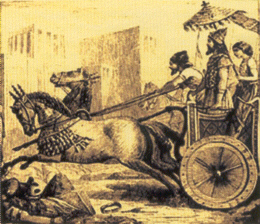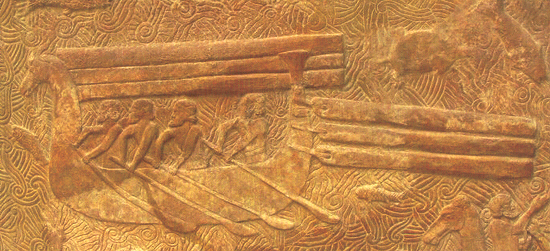|
Mesopotamia,
is Greek for ‘…between the rivers…’ and refers to the
valley between the Euphrates and Tigris. It lies
approximately eight hundred miles Northeast of Egypt in
the land of modern days Iraq. It has had many names: ‘
Land of Shinar’,’ Sumer’ or in Sumerian ‘ki-en-gir’
which translates as something like ‘land of the
civilised lords’. It formed a Kingdom 170 miles long
and only 40 miles wide and had as its capital the fabled
city of Babylon.
The twin rivers, born in the mountainous lands of Asia
Minor, created a stretch of green land still widely
known as the “Fertile Crescent.” It was perfect spot
for agriculture with water and sun in abundance
supplementing the wondrously fertile silt deposited by
the rivers. It yielded enormous quantities of grain and
dates and made an ideal place to breed cattle. The clay
from the river was an ideal material for making bricks
and, later, fine enamelled pottery.
It is then no wonder that the settlers here created a
society widely held to be the first to qualify as a
‘Civilisation’.
Sumer, Akkadia, Babylon and Assyria make full items on
their own in the history.
The Sumerians, the Akkadians, the Assyrians and others,
Semitic and non-Semitic
alike, were remarkable people living in remarkable
times. They were the first people known to have used
wheeled vehicles for transport and warfare. The first
true city states arose in Sumer, roughly
contemporaneously with similar entities in what is now
Syria and Palestine, starting in the 4th
millennium BCE.
They invented and developed arithmetic. Their
sexagesimal (using a mix of base 6 and 10) system became
the standard number system in Sumer and Babylonia. Using
the sexagesimal system they evolved the clock with its
60 seconds, 60 minutes, and 12 hours, and the 12 month
calendar which is still in use.
They probably invented military formations as we now
know them and introduced the basic divisions between
infantry, cavalry and archers.
They developed the first known codified legal and
administrative systems, complete with courts, jails, and
government records.
Several centuries after their invention of cuneiform,
the practice of writing expanded beyond the simple
trading records it was used for originally and was
applied for the first time about 2600 BC to written
messages and mail delivery, history, legends,
mathematics, astronomical records and other pursuits
generally corresponding to the fields occupying teachers
and students ever since. And so it led to the
establishment of the first formal schools under the
control of the primary temple of one of the dozen or so
City-states that made up the country.
The history of the Mesopotamian region as a whole is
filled with names we all learned at school – names that
seem somehow redolent of myth and fable as much as of
history.
Sargon of Akkad was one of history’s great monarchs
though what is reported of his early life and rise to
power owes as much to myth as to history. What is
undeniable is that around 2300BCE he created and ran an
Empire reaching from Elam on the Mediterranean coast to
the South of Modern Iraq and East past Persia and into
Anatolia.
Hammurabi
the Lawgiver was the sixth King of Babylon. He conquered
Sumer and Akkad, ending the last Sumerian dynasty of
Isin and became the first king of the Babylonian Empire
which he reigned over from 1792 BCE until his death in
1750 BCE.
He is perhaps best known for promulgating his code of
laws, known as the Code of Hammurabi which was a major
stepping stone on the road to modern ideas of
civilisation. The idea of "innocent until proven
guilty", so central to Western concepts of justice,
comes straight from the laws he imposed.

Sennacherib (705 BCE–681 BCE), son of Sargon II
concentrated on building and beautifying the City of
Nineveh in the mountains. He made it his capital
meticulously laid-out and complete with statues, parks
and avenues along with other works of art. He assured
the water supply to the citizens of using a mechanical
device that sucked up the underground water and stored
it in a vast underground reservoir. The story of his
failure to take Jerusalem and his subsequent downfall is
told in the Bible and in Lord Byron's poem.
The
Destruction of Sennacherib with its famous quote "The
Assyrian came down like the wolf on the fold..."
Assurbanipal or, in Akkadian,
A_ur-b_ni_apli, reigned
660 BCE – 625 BCE or thereabouts. The grandson of
Sennacherib was the last great king of ancient Assyria
and is famous as one of the few kings in antiquity who
could himself read and write. He proved that he was a
great builder like his grandfather and secured for
himself a place in history as a Lawgiver with a complete
code of history. He became the last great king to rule
Nineveh before it collapsed during the 7th century BCE.
The Chaldean, Nebuchadnazzar (604-561 BCE), extended his
conquests over the kingdom of Judah and destroyed the
famous Temple of Solomon and led the surviving Jews into
captivity to Babylon.
But he was a wise and able ruler who maintained an iron
grip over the affairs of the empire under his rule. He
brought prosperity to the region not known since
Hammurabi’s time. He rebuilt the city of Babylon and
constructed the Hanging Gardens for his homesick Persian
consort who missed the green hills of her own land. This
wonderful garden was immortalized by Greek scholars as
one of the Seven Wonders of the Ancient World. The
Chaldeans encouraged education and learning and the
pursuit of science. These sciences would eventually form
the basis of scientific development in Greek and Roman
times.
This then was the legacy of the people of the region to
us today. Science, technology, art, politics, civics,
law, military and social planning; all this can be
traced back to the Sumerians and their successors.

The Sumerians themselves placed a great importance on
cultivating their land, by building canals and
embankments to increase their agricultural output. They
had organized their trade into a complex system of
economics life and had created systems which closely
resembled modern banking. They were the first to invent
an Alphabet which they initially used to record business
transactions. This is the alphabet known to us as
Cuneiform (wedge shaped) after the shapes made by sharp
instruments on baked pieces of clay.
The Akkadians who came after them relied heavily on
their army and military strength for gaining power. They
introduced new systems of weapons and warfare which were
unknown to the Sumerians.
The Amorites paid great attention to the welfare of
their people and under the rule of Hammurabi gave the
Mesopotamians a comprehensive system of by which they
could govern themselves. Nearly 300 pieces of these laws
are still retained by the governments of the modern
world intact in their constitutions. His rule gave a
boost to agriculture, trade and industry. He connected
the cities of his kingdoms with proper roads and
provided security for his citizens by policing these
highways with the help of his army which enhanced peace
and prosperity in the Empire.
Many of the Mesopotamian rulers were great patrons of
art, architecture, learning, education and science.
Schools were found all over the Empire for children who
had to master the use of the Sumerian alphabet from an
early age. They preserved all their records and history
by inscribing it with sharp instruments on baked pieces
of clay.
The Assyrians under Assurbanipal had built up a great
library of arts and sciences to encourage learning among
scholars. They constructed magnificent buildings,
stepped pyramid temples (ziggurats) and palaces. They
embellished them with sophisticated works of art and
encouraged architecture as a major branch of learning.
Sumerian fabrics were famous all over the known world at
that time and they traded extensively in it. They
developed a woollen textile industry which helped the
people to live in winter seasons comfortably and kept
them warm in the cold climate. Jewellery making and
pottery designs were developed into a highly
sophisticated art, beautifully coloured and enamelled.
They also developed a formal system of weights and
measures. They did their counting by sixties – not by
tens as it is done today – and it was from the Sumerians
that modern civilisations inherited the system of
calculating their time of minutes and seconds in
sixties.
They developed an accurate lunar calendar with an
additional month every eleven years to conform to the
solar calendar.
Women enjoyed exceptional rights during the time of
Hammurabi. They had a right to property and freedom of
education. They were free to practice the profession of
their choice. Artisans used their services for making
copper and silver utensils. They worked in the textile
industry. Most remarkably for the time women were free
to trade on their own across land, river, and sea routes
which took them sometimes as far as India.
Trade was done by barter system where they exchanged
goods for precious metals like gold and silver. Women
often helped the merchants by acting as scribes.
They also had the right of inheritance, marriage and
divorce. This freedom declined after Hammurabi’s time
and eventually women were
pushed into the background losing so much of the
independence and equality shown in his time.

Their social lives were divided into a strict religious
hierarchy. The upper classes were the priests, high
officials and rich merchants. The middle classes were
made up of artisans, shop owners, farmers and freemen.
In the lowest class were the slaves. Slavery was an
established institution, although slaves also enjoyed
certain rights, like owning property or marrying into
the family of freemen, under the benevolent rule of
Hammurabi. But even the Laws of Hammurabi were partial
towards the upper classes and were severe while dealing
with those belonging to the lower classes. Heavy
penalties were imposed on the slaves when they disobeyed
their masters.
Early Sumerian records give us stories that are familiar
to us today.They tell us, for example, of a pious man
named Ziusudra who built an ark and saved his family and
himself from the Wrath of God, an account that is
preserved in other ancient religious texts including the
Bible, where he is described as Noah and the Holy Qur’an
also confirms that the Prophet Nuh was indeed a true and
mighty Messenger of God sent to warn those who had taken
to the worship of their ancestors.
These ancient texts tell us also the story of the
Abraham and the cruelties he suffered in Ur under
Nimrod, King of Babylon. We also have accounts of the
friendship of David with the Assyrian King Tiglath
Pilser I.
But throughout Mesopotamia people worshiped many gods.
They would erect ziggurats in their honour. These had
great terraced towers of seven stories, rather like a
modern skyscrapers, on the top story of which stood the
shrine of their favourite God. The lower levels
meanwhile were used by rich merchants in the priestly
class to trade in goods.
The Land Between the Rivers really was the cradle of
civilisation as we know it. We see their legacy around
us every day and we live it in our daily lives. The
first traces of the monotheism that ultimately gave life
to Islam and the teachings of Prophet Mohammed (pbuh)
can be found 6000 years ago and felt just as strongly
today. | 